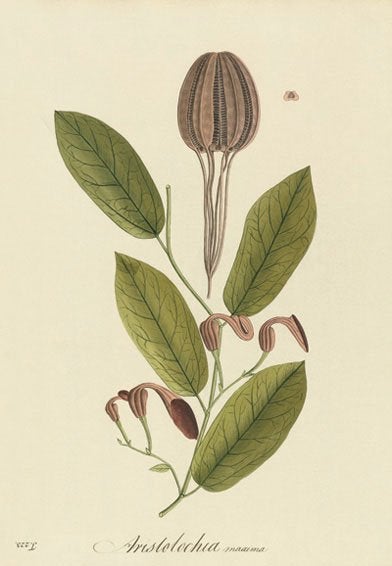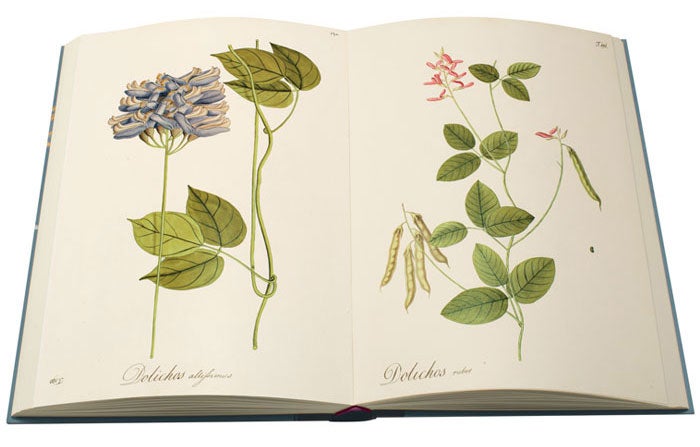
Charles Darwin’s The Descent of Man applies his revolutionary theory to human evolution. This exceptional Folio collector’s edition is introduced by Richard Dawkins and includes numerous colour illustrations, as well as diagrams and figures.
Illustrated by Bauer et al
Limited to 750 hand-numbered copies
The first facsimile of one of the great books of botanic art from the edition held in the library of the Royal Botanic Gardens, Kew.
Plates Volume
272 pages including 264 full-page colour plates and two tipped-in fold-outs
Printed on Veltique paper
Quarter-bound in goatskin with cloth sides blocked in gold, silver and black with a design by Neil Gower
Gilded top edge
18½˝ x 13˝
Commentary Volume
56 pages, including 10 full-page illustrations
Typeset in Miller and printed on Veltique paper
Bound in cloth blocked in black and gold with a design by Neil Gower
8½˝ x 11¾˝
Solander Presentation Box
Bound in Balmoral cloth
Blocked in gold on front and spine
Three full-size plates presented for framing
Plants of the Americas, the sumptuous second edition (1780) of the Selectarum stirpium Americanarum historia – written by the Dutch-born Austrian botanist Nikolaus von Jacquin and illustrated by some of the finest botanic artists Europe has ever produced – is by the standards of any age an astounding artistic and intellectual achievement. Here for the first time, in full colour and fine detail, was a treasury of exotic plants which had never reached European shores before its author’s daring voyage to the West Indies in search of new species. It was the product of a remarkable age of unfettered scientific inquiry, the Enlightenment.
This was the age of the philosophers Montesquieu, Rousseau and Voltaire, of John Hume, Adam Smith and Immanuel Kant, of Benjamin Franklin and Thomas Jefferson. It was also a time of great scientific advancement, enabled by an unprecedented combination of rational thought and empirical observation.
Franz I, the Holy Roman Emperor and Archduke of Austria, was one of the so-called ‘enlightened despots’ who recognised the national prestige to be won through the pioneering achievements of Enlightenment intellectuals. It was in this spirit that he invited Nikolaus von Jacquin to conduct an expedition to the Americas and bring back exotic plants and animals for his garden and menagerie at Schönbrunn Palace, on the outskirts of Vienna.
Jacquin left Vienna in 1754 and spent the following five years collecting, recording and shipping back specimens from across the Caribbean region – Martinique, the Leeward Islands and Antilles, Jamaica, Cuba and the Colombian coast. In the course of his voyage Jacquin’s herbarium was destroyed by termites, prompting him to make drawings in situ of the species he had discovered – the originals from which many of the beautiful plates of Plants of the Americas were painted. He endured the looting and burning of his ship by English pirates, contracted and then shook off yellow fever, and at one point fell from a cliff and landed on a cactus. For all his sufferings, the expedition proved a resounding success: shells, fossils, corals, plants, birds and small mammals were transported back to Schönbrunn, and Jacquin had succeeded both in discovering many new species and in correcting numerous taxonomical errors.
On his return to Europe, Jacquin’s publications secured his reputation as a botanist – the ‘Ambassador of Flora’ in the words of Carl Linnaeus – but something greater was in store. In 1780 he published the second edition of Plants of the Americas. This book, referred to variously as the ‘deluxe’, ‘luxury’, ‘extravagant’ or ‘eccentric’ edition, was a true meeting of science and art, with breathtaking results – 264 hand-painted plant portraits of extraordinary detail and accuracy, prefaced by a title page of exuberant beauty.

‘In the delineation of plants he united the accuracy of a profound naturalist with the skill of the accomplished artist, to a degree which has been only equalled by his brother Ferdinand’
- Epitaph to Franz Bauer, St Anne’s Church, Kew
While the plant portraits are technical and artistic masterpieces, the pictorial title page of Plants of the Americas is an explosively colourful celebration of nature’s floral munificence. Across the thirty-one known surviving copies of the book, ten different designs have been identified, of varying degrees of lushness and complexity. Oddly, the plants and insects depicted in these paintings are recognisably European. While this disparity may seem curious, these bravura pieces allowed Jacquin’s artists to display their talents to the full, and they open Plants of the Americas on an arrestingly beautiful and disarmingly eccentric note.
Who were these artists? The paintings produced from Jacquin’s original drawings bear no mark of authorship. The title pages of different copies, however, are variously signed ‘Franz Bauer’, ‘Franc Bauer’ and ‘F. Bauer’, suggesting that the prodigiously talented botanical artists Franz Bauer and his younger brother Ferdinand, both of whom were active in Vienna at this time, played a leading role in the illustration of the book. After prestigious commissions in their native Feldsberg and then Vienna, the brothers eventually found fame in England – Franz as resident flower artist at Kew and official Botanick Painter to King George III, Ferdinand as artist of another of the great natural history books, the Flora Graeca. While it remains impossible to determine exactly who painted which of the plant portraits in the book, the deluxe edition of Plants of the Americas is at least in part the work of the brothers who were widely recognised as Europe’s finest botanical artists.

For this facsimile Christopher Mills, Head of Library, Art and Archives at the Royal Botanic Gardens, Kew, has produced a comprehensive account of the genesis and publication of Plants of the Americas, with complete details of the surviving copies of the deluxe second edition and full-colour reproductions of all ten variants of the book’s stunning title page. He also documents all the plant species illustrated in Plants of the Americas and provides an extensive bibliography. Richard Deverell, Director of Kew Gardens, has contributed a foreword in which he pays tribute to the beauty and continuing relevance of Jacquin’s great work.
